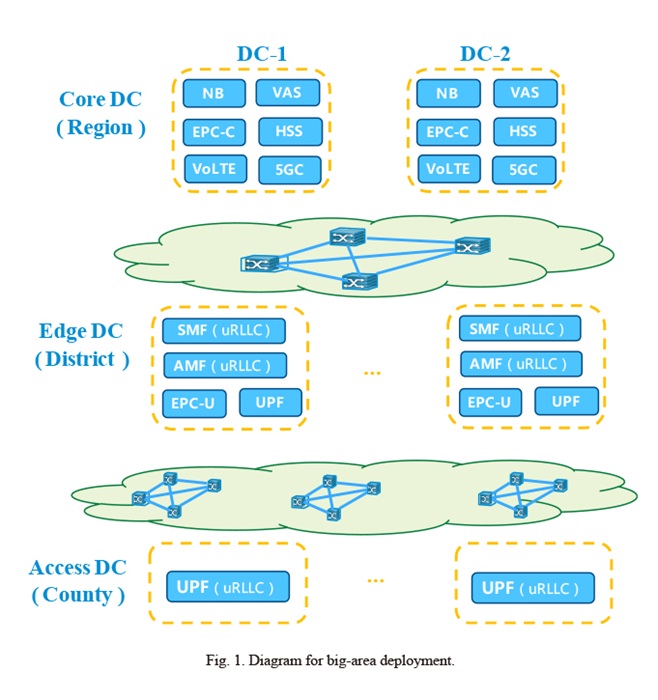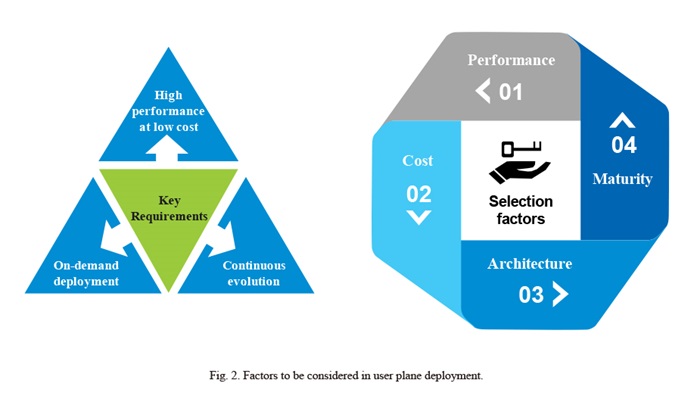A Probe into Big-Area Deployment of Virtualized Core Network
Network function virtualization (NFV) is the development trend of core network. The most important feature of NFV is to use the common hardware and NFVI to provide unified operation resources for all the higher-level VNFs. The NFV technology provides the basis for flexible deployment, rapid delivery, smart and automated O&M of VNFs, and network transformation. It enables the decoupling of NE software from underlying hardware so that the deployment of VNFs no longer depends on the dedicated hardware, which also makes centralized and large-scale network deployment possible. This article briefly analyzes centralized deployment of a virtualized core network shared across a big area.
The big-area centralized deployment is opposed to distributed deployment by province. In the existing telecom networks (physical equipment), each provincial branch of the operator has its independent equipment room, hardware, software, and BOSS. Resources from different provinces are mutually independent, so both hardware and software are maintained on a provincial basis. The big-area centralized deployment means that the network devices from multiple provinces are centrally deployed and maintained to provide network services to all the users in the coverage area. In general, NEs that are deployed centrally in a big-area DC include service NEs, data management NEs, control plane NEs, and latency-insensitive user plane NEs. User plane NEs are deployed on demand according to the geographical area size. If the area is small, 4G EPC user planes and 5G eMBB UPFs can be deployed centrally. If the area is large, 4G EPC user planes and 5G UPFs can be moved to edge DCs or access DCs (Fig. 1).

Issues in Big-Area Centralized Deployment
Since the big-area centralized core network deployment is significantly different from the distributed deployment in different provinces, it is necessary to make comprehensive analysis. Great attention should be paid to the following issues.
Transmission
The big-area centralized deployment means that the traffic needs to be converged. The control plane traffic and user plane traffic (all or partial) need to be converged in the DCs where VNFs are centralized. It is necessary to build a new transmission network or transform the existing transmission network, especially that between wireless network and core network. Wireless networks are deployed in different provinces. Core network centralization means that the backhaul networks must be converged in the big area. The larger user base a big area has, the higher transmission bandwidth is required. In addition, along with the increase of user traffic, the demand for higher transmission bandwidth will also be increasing.
Latency
In a wireless network, services have varying QoS demands. There are latency-insensitive services (e.g. NB-IoT), latency-sensitive services (e.g. real-time gaming, voice, and real-time video), and ultra-low latency services (e.g. connected autonomous driving and industry control). Different levels of QoS should be deployed to ensure a good user experience.
Disaster Recovery
It is necessary to take disaster recovery into consideration so that large-area centralized deployment have the same disaster recovery capability as the existing provincially distributed deployment mode.
Interoperation
It is also necessary to consider the interoperation with the existing network in each province to ensure the service continuity and promote user experience.
Service Migration
The large-area centralized deployment mode will coexist for a long time with the existing provincially distributed deployment mode, and a long-term plan should be made to ensure that users can be migrated smoothly from a province to a big area.
Resource Use Ratio
The resource utilization ratio could be increased by giving full play to the centralization advantage and exploiting the potential of cloudified networks.
O&M
One of the advantages of the large-area centralized deployment lies in the large-scale resource pool. Both NFVI and VNFs can centrally operated and maintained, and automation tools must be deployed to promote O&M efficiency. Technologies such as big data analysis and AI can be used to increase O&M automation levels and reduce the maintenance costs.
Coordination
While core networks are centralized to support a large area, wireless networks and existing networks are still configured for different provinces. It is necessary to consider the coordination between a large area and a provincial branch, including organization structure change, division of responsibilities, fault processing flow, service development coordination, and differentiated operations.
Analysis of User Plane Deployment Forms
In the big-area core network deployment scenario, control plane NEs would normally use the NFV equipment. The deployment form of user plane NEs (such as 4G GW-U and 5G UPF) is currently one of the hot topics. The user plane deployment should take the following factors into consideration (Fig. 2).

Three Major Demands
●High performance at low cost: High throughput and low latency need to be provided at lower costs to accommodate the explosive growth of traffic and support high bandwidth, low latency services.
●On-demand deployment: The user plane should be capable of rapid deployment, dynamic position adjustments, rapid enablement of new services, and elastic resource scaling to meet the specific QoS requirements of each vertical industry.
●Continuous evolution: There should be smooth evolution towards a 4G/5G converged user plane and unified access to ensure voice and data continuity.
Four Big Factors in User Plane Selection
●Performance: A user plane should not only support existing EPC scenarios but also exponential traffic growth envisaged for 5G networks. With the reduction of tariffs and emergence of more high-bandwidth services, user traffic has been increasing at an enormous pace, and thus the user-plane performance must match the traffic growth. With the improved performance of COTS servers, the user plane performance of the NFV architecture is equivalent to that of the traditional equipment. In addition, with the rapid improvement of the performance of universal CPU and the development of software acceleration and hardware acceleration technologies, the NFV user plane performance is being promoted rapidly.
●Cost: When the data roaming charges are removed and the number of unlimited data users is increasing rapidly, the operator faces the problem of how to reduce TCO. The traditional dedicated CPU equipment evolves slowly, and its cost is not controllable. However, the cost of NFV equipment is transparent, and its purchase cost decreases at a speed faster than that of traditional equipment. NFV devices can be deployed in centralized mode to cover a large area for centralized O&M and management, significantly reducing O&M costs and improving the resource utilization ratio.
●Architecture: The user plane architecture needs to meet the demands for on-demand, flexible deployment and long-term evolution. 5G will be designed to support diverse types of services with different QoS requirements, which requires that the user plane can be deployed on demand to meet different service requirements. Traditional user plane devices based on the solidified hardware architecture cannot be elastically expanded or deployed, whereas the NFV user plane equipment offers deployment flexibility. In the 5G network slicing scenario, the NFV equipment can better meet the personalized demands of users.
●Maturity: The selection of the form of a user plane depends on the maturity of the industry chain. In the IT field, the virtualized equipment has been deployed on a big scale, and in the CT field, hundreds of commercial vEPC networks have been running stably across the world. Thus, extensive experience has been accumulated.
To sum up, the virtualized user plane has more advanced architecture, transparent hardware cost, low O&M costs and good scalability, meeting key demands and long-term evolution targets of the network. Under the condition of meeting QoS, the user plane can be deployed for a big area to enlarge the capacity of a resource pool, improve the utilization ratio of the resource pool, and increase the maintenance efficiency.